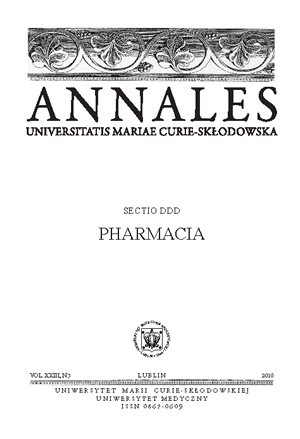Comparison of the course of type 2 diabetes in village and town inhabitants in the Lublin region.
Keywords:
diabetes type 2, villages, town, metabolic compensation, obesityAbstract
Introduction: Diabetes type 2, a chronic metabolic disorder and frequent lifestyle disease is, according to WHO, the biggest unsolved problem of public health.
The aim of the study was to compare the course of diabetes type 2 in village and town inhabitants in the Lublin region hospitalized in the Endocrinology Clinic for 3 years.
Material and Methods: The analysis was based on the retrospective evaluation of medical history of 703 patients with diabetes type 2 hospitalized in the Endocrinology Clinic November 2006–October 2009, including 204 country dwellers (29%) and 499 town dwellers (71%) with mean disease duration 11±8.5 years. The following parameters were analyzed: reasons for hospitalization, disease duration, anthropometric features, metabolic compensation criteria, presence of chronic complications and types of hypoglycemic treatment.
Results: In both groups, the main reason for hospitalization was the lack of metabolic compensation. Mean fasting glucose levels were considerably higher in patients from towns than those of from villages, though, this fact was not significantly reflected in HbA1c values. No significant difference between the groups was found with regard to the patients' age, disease duration, total cholesterol, HDL cholesterol, triglycerides, creatinine, microalbuminuria, blood pressure or the presence and types of chronic vascular complications. Mean BMI was considerably higher in country dwellers than in town ones, respectively: 34.3±19.6 vs. 30.7±10.7, p<0.001. The tested groups did not meet the metabolic compensation criteria of the PDA to the similar extent. Both groups were treated mainly with insulinotherapy.
Conclusions: In the population of patients with type 2 diabetes in the Lublin region, the place of abode does not affect the course of diabetes type 2, though BMI was higher in village than in town inhabitants. Despite higher fasting glucose levels in patients from towns, no significant HbA1c values were noted as compared to those of the country dwellers.
References
1. Chan RS, Woo J. Prevention of overweight and obesity: how effective is the current public health approach. Int J Environ Res Public Health. 2010; 7:765-83.
2. Chiasson JL. Early insulin use in type 2 diabetes: what are the cons? Diabetes Care. 2009;32 Suppl 2:S270-4.
3. Gaede P, Valentine WJ, Palmer AJ, et.al. Cost-effectiveness of intensified versus conventional multifactorial intervention in type 2 diabetes: results and projections from the Steno-2 study. Diabetes Care. 2008;31:1510-5.
4. Grzeszczak W., Sieradzki J., Kasperska-Czyżyk T., et al. Oraz Zespół Badaczy DINAMIC 2:Badanie DINAMIC 2: porównanie wyników w różnych regionach Polski (III). Diabetologia Praktyczna 2003; 4, 2: 111–124.
5. Gumprecht J, Grzeszczak W: Zasady insulinoterapii u chorych na cukrzycę typu 2. Przew Lek 2003, 6, 5, 10-14
6. King H, Aubert RE, Herman WH. Global burden of diabetes, 1995-2025: prevalence, numerical estimates, and projections. Diabetes Care. 1998; 21:1414-31.
7. Klein S, Sheard NF, Pi-Sunyer X, et al. Weight management through lifestyle modification for the prevention and management of type 2 diabetes: rationale and strategies: a statement of the American Diabetes Association, the North American Association for the Study of Obesity, and the American Society for Clinical Nutrition. Diabetes Care. 2004;27:2067-73.
8. Malec K, Molęda P, Homa K, et al. Wyrównanie cukrzycy u chorych na cukrzycę typu 2 zamieszkujących gminę rolniczą w województwie zachodniopomorskim. Diabetologia Praktyczna 2007, tom 8, 8–9, 295–300.
9. Matuszek B, Lenart-Lipińska M, Wdowiak-Barton B, et al. Does the body mass influence the level of metabolic compensation in patients with diabetes mellitus type 2?Ann. UMCS Sect. DDD 2008 vol. 21 nr 1, s. 369-72.
10. Meigs JB. Epidemiology of type 2 diabetes and cardiovascular disease: translation from population to prevention: the Kelly West award lecture 2009. Diabetes Care. 2010;33:1865-71.
11. Nathan DM, Kuenen J, Borg R, et al. A1c-Derived Average Glucose Study Group. Translating the A1C assay into estimated average glucose values. Diabetes Care. 2008;31(8):1473-8.
12. Peters AL. Patient and treatment perspectives: Revisiting the link between type 2 diabetes, weight gain, and cardiovascular risk. Cleve Clin J Med. 2009;76 Suppl 5:S20-7.
13. Raport of a WHO Study Group. Geneva World Health Org.: Definition, diagnosis, and classification of diabetes mellitus and its complications. Geneva 1999. Medycyna Prakt., 2000; 1-2:85-124.
14. Schiel R, Hoffmann A, Müller U. Quality of diabetes care in patients living in a rural
area of Germany. Results of a Population-Based study – The ZEUVIN trial. Med Klin.1999; 94: 127-132.
15. Sieradzki J., Grzeszczak W., Karnafel W., et al. Badanie PolDiab. Część 1. Analiza leczenia cukrzycy w Polsce. Diabetologia Praktyczna 2006; 7: 8–15.
16. Sieradzki J., Kasperska-Czyżyk T., Grzeszczak W., et al. oraz Zespół Badaczy DINAMIC 2: Wyniki ogólnopolskie badania DINAMIC 2 (II). Diabetologia Praktyczna 2003; 4, 2: 103–110.
17. Szurkowska M, Pyrzyk B, Nazim A, et al. Ocena jakości leczenia chorych na cukrzycę
typu 2 w populacji wielkomiejskiej i w populacji wiejskiej. Diabet Pol. 2002; 9:103-109.
18. Wild S, Roglic G, Green A, et al. Global prevalence of diabetes: estimates for the year 2000 and projections for 2030. Diabetes Care. 2004;27:1047-53.
19. Wysham CH.: New perspectives in type 2 diabetes, cardiovascular risk, and treatment goals. Postgrad Med. 2010 May;122(3):52-60.
20. Zalecenia kliniczne dotyczące postępowania u chorych na cukrzycę 2010. Stanowisko Polskiego Towarzystwa Diabetologicznego. Diabetologia Praktyczna, 2010,11, supl A, 38-43.
Downloads
Published
Issue
Section
License
Copyright (c) 2010 Authors

This work is licensed under a Creative Commons Attribution-NonCommercial-NoDerivatives 3.0 Unported License.


